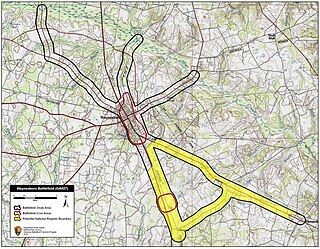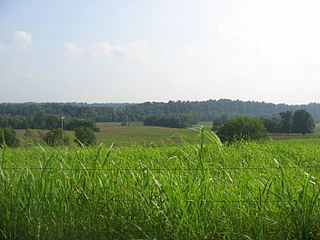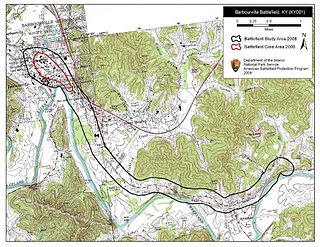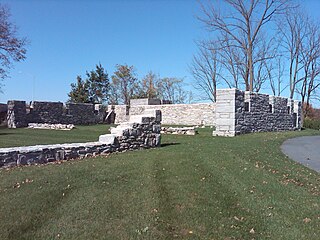
The Battle of Lookout Mountain also known as the Battle Above the Clouds was fought November 24, 1863, as part of the Chattanooga Campaign of the American Civil War. Union forces under Maj. Gen. Joseph Hooker assaulted Lookout Mountain, Chattanooga, Tennessee, and defeated Confederate forces commanded by Maj. Gen. Carter L. Stevenson. Lookout Mountain was one engagement in the Chattanooga battles between Maj. Gen. Ulysses S. Grant's Military Division of the Mississippi and the Confederate Army of Tennessee, commanded by Gen. Braxton Bragg. It drove in the Confederate left flank and allowed Hooker's men to assist in the Battle of Missionary Ridge the following day, which routed Bragg's army, lifting the siege of Union forces in Chattanooga, and opening the gateway into the Deep South.

The Battle of Nashville was a two-day battle in the Franklin-Nashville Campaign that represented the end of large-scale fighting west of the coastal states in the American Civil War. It was fought at Nashville, Tennessee, on December 15–16, 1864, between the Confederate Army of Tennessee under Lieutenant General John Bell Hood and the Union Army of the Cumberland (AoC) under Major General George H. Thomas. In one of the largest victories achieved by the Union Army during the war, Thomas attacked and routed Hood's army, largely destroying it as an effective fighting force.

The Battle of Rich Mountain took place on July 11, 1861, in Randolph County, Virginia as part of the Operations in Western Virginia Campaign during the American Civil War.

The siege of Corinth was an American Civil War engagement lasting from April 29 to May 30, 1862, in Corinth, Mississippi. A collection of Union forces under the overall command of Major General Henry Halleck engaged in a month-long siege of the city, whose Confederate occupants were commanded by General P.G.T. Beauregard. The siege resulted in the capture of the town by Federal forces.

The Carolinas campaign, also known as the campaign of the Carolinas, was the final campaign conducted by the Union Army against the Confederate Army in the Western Theater of the American Civil War. On January 1, Union Maj. Gen. William T. Sherman advanced north from Savannah, Georgia, through the Carolinas, with the intention of linking up with Union forces in Virginia. The campaign culminated in the defeat of Confederate Gen. Joseph E. Johnston's army at the Battle of Bentonville, and its unconditional surrender to Union forces on April 26, 1865. Coming just two weeks after the defeat of Robert E. Lee's army at the Battle of Appomattox Court House, it signaled that the war was effectively over.

The Battle of Ringgold Gap was fought November 27, 1863, outside the town of Ringgold, Georgia, by the Confederate and Union armies during the American Civil War. Part of the Chattanooga Campaign, it followed a heavy Confederate loss at the Battle of Missionary Ridge from which General Braxton Bragg's artillery and wagon trains were forced to retreat south. The five hour Battle of Ringgold Gap resulted in the Confederate victory of Major General Patrick R. Cleburne and gave the Army of Tennessee safe passage to retreat through the Ringgold Gap mountain pass.

The Battle of Waynesboro was an American Civil War battle fought on December 4, 1864, in eastern Georgia, towards the end of Sherman's March to the Sea. Union cavalry forces under Brig. Gen. Judson Kilpatrick defeated Confederate cavalry led by Maj. Gen. Joseph Wheeler, opening the way for William T. Sherman's armies to approach their objective, Savannah.
The Battle of Griswoldville was the first battle of Sherman's March to the Sea, fought November 22, 1864, during the American Civil War. A Union Army brigade under Brig. Gen. Charles C. Walcutt fought three brigades of Georgia militia under Brig. Gen. Pleasant J. Philips, at Griswoldville, near Macon, Georgia, and continued its march toward Savannah.

George Gibbs Dibrell was an American lawyer and a five-term member of the United States House of Representatives from the 3rd Congressional District of Tennessee. He also served as a general in the Confederate States Army during the American Civil War and as a railroad executive.

The Battle of Tebbs Bend was fought on July 4, 1863, near the Green River in Taylor County, Kentucky during Morgan's Raid in the American Civil War. Despite being badly outnumbered, elements of the Union Army defeated Confederate Brig. Gen. John Hunt Morgan's dismounted cavalry.

The Battle of Barbourville was one of the early engagements of the American Civil War. It took place on September 19, 1861, in Knox County, Kentucky during the campaign known as the Kentucky Confederate Offensive. The battle is considered the first Confederate victory in the commonwealth, and threw a scare into Federal commanders, who rushed troops to central Kentucky to try to repel the invasion, which was finally stopped at the Battle of Camp Wildcat in October.

The Defense of Cincinnati occurred during what is now referred to as the Confederate Heartland Offensive or Kentucky Campaign of the American Civil War, from September 1 through September 13, 1862. Confederate Brigadier General Henry Heth was sent north from Lexington, Kentucky, to threaten Cincinnati, Ohio, then the sixth-largest city in the United States. Heth was under orders from his superior, Major General Edmund Kirby Smith, not to attack the city, but to instead make a "demonstration". Once Heth arrived and reconnoitered the defenses, he realized an attack was pointless. After a few minor skirmishes, he took his men back to Lexington.

The Skirmish of Sporting Hill was a relatively small skirmish during the Gettysburg campaign of the American Civil War, taking place on June 30, 1863, at various locations in present-day Camp Hill, East Pennsboro Township and Hampden Township in Cumberland County, Pennsylvania. It is known as the northernmost engagement of Robert E. Lee's Army of Northern Virginia during the Civil War.

The Knoxville campaign was a series of American Civil War battles and maneuvers in East Tennessee, United States, during the fall of 1863, designed to secure control of the city of Knoxville and with it the railroad that linked the Confederacy east and west, and position the First Corps under Lt. Gen. James Longstreet for return to the Army of Northern Virginia. Union Army forces under Maj. Gen. Ambrose Burnside occupied Knoxville, Tennessee, and Confederate States Army forces under Longstreet were detached from Gen. Braxton Bragg's Army of Tennessee at Chattanooga to prevent Burnside's reinforcement of the besieged Federal forces there. Ultimately, Longstreet's Siege of Knoxville ended when Union Maj. Gen. William Tecumseh Sherman led elements of the Army of the Tennessee and other troops to Burnside's relief after Union troops had broken the Confederate siege of Chattanooga. Although Longstreet was one of Gen. Robert E. Lee's best corps commanders in the East in the Army of Northern Virginia, he was unsuccessful in his attempt to penetrate the Knoxville defenses and take the city.

Columbia, the capital city of South Carolina, was an important political and supply center for the Confederate States Army during the American Civil War. Much of the town was destroyed during occupation by Union forces under Major General William T. Sherman during the Carolinas Campaign in the last months of the war. Sherman was accused of having deliberately and needlessly burned the city, which he denied. Modern historians say that multiple causes were responsible.

During the American Civil War, Pennsylvania was the second largest state in the Union, and Harrisburg was the state's capital. Located at the intersection of important railroads, Harrisburg proved an important supply and logistics center for the dissemination and transportation of materiel for the Union Army. Tens of thousands of new recruits were mustered into service or drilled at a series of Harrisburg-area United States Army training camps, including the sprawling Camp Curtin. Confederate forces under Lieutenant General Richard S. Ewell threatened Harrisburg during the June 1863 Gettysburg Campaign, but were instead called by General Robert E. Lee to return to Gettysburg campaign. Pennsylvania Governor Andrew Curtin ordered local workers to erect a series of forts and earthworks to protect the city, which then had a population of 13,000 residents.

The 53rd Pennsylvania Volunteer Infantry was a volunteer infantry regiment in the Union Army during the American Civil War.

James St. Clair Morton was an American military officer who served as chief engineer of the Army of the Ohio, the Army of the Cumberland and the XI Corps in the Union Army during the American Civil War. He led construction of key embattlements protecting Nashville, Tennessee including Fort Negley and Fortress Rosencrans. He served as major in the regular army and was promoted to brigadier general of the Pioneer Brigade in the volunteer army. Morton requested a reduction in rank from brigadier general of volunteers after being reprimanded by General William Rosecrans in front of colleagues due to drunkenness in the ranks and errors in troop placement. He was killed in action during the Second Battle of Petersburg and brevetted brigadier general posthumously.

Fort Granger was a Union fort built in 1862 in Franklin, Tennessee, south of Nashville, after their forces occupied the state during the American Civil War. One of several fortifications constructed in the Franklin Battlefield, the fort was used by Union troops to defend their positions in Middle Tennessee against Confederate attackers. The Second Battle of Franklin in 1864, part of the Franklin-Nashville Campaign in the Western Theater, was the most notable engagement of this area during the Civil War.

The Battle of Philadelphia saw the Confederate cavalry brigades of Colonels J. J. Morrison and George Gibbs Dibrell attack a Union cavalry brigade under Colonel Frank Wolford at Philadelphia, Tennessee, during the Knoxville campaign of the American Civil War. While Dibrell's brigade skirmished with Wolford's cavalrymen, Morrison led his brigade around the west side of Philadelphia to attack the Union force from the rear. Wolford sent half his brigade to counter Morrison's envelopment, but Dibrell's soldiers suddenly attacked. The Confederates completely routed Wolford's troopers, capturing over 400. A Union infantry-cavalry force reoccupied Philadelphia the next day, but a week later it withdrew to the north bank of the Tennessee River, abandoning Loudon, Tennessee.



















